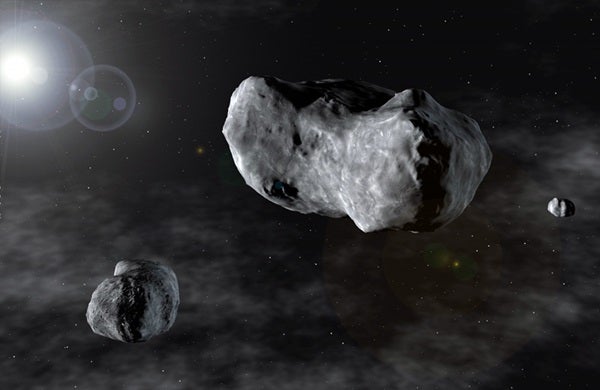Two small moons orbit asteroid 87 Sylvia, astronomers announced today. A previous study identified one moon in 2001, but the discovery of a second body makes this the first known triple-asteroid system.
Astronomer Franck Marchis of the University of California, Berkeley, led the team that uncovered Sylvia’s second satellite. The group made the discovery using Yepun, one of the European Southern Observatory’s 8-meter telescopes in the Very Large Telescope Array at Cerro Paranal, Chile. They collected the data remotely and later analyzed it on DVD. The telescope’s adaptive optics instrument, NACO, which automatically assesses and accounts for image distortion caused by Earth’s atmosphere, provided the high resolution needed to observe the moonlets.
Sylvia, which was discovered in 1866, resides 3.5 AU away in the main asteroid belt, between Mars and Jupiter’s orbits (1 AU is the average Earth-Sun distance). The asteroid was named for Rhea Sylvia, the mythological mother of the founders of Rome, and the moons have been named after her twin children: Romulus and Remus.
Newfound Remus measures just 4 miles (7 kilometers) across and orbits Sylvia at a distance of 441 miles (710 km). Romulus, at 11 miles (18 km) wide, is more than twice as large and circles the asteroid at nearly twice the distance, 845 miles (1360 km). Both moons orbit in the same plane and direction.
Detailed observations of the system also allowed Marchis’ group to calculate Sylvia’s mass and density precisely. The new data reveal Sylvia’s density is only 20-percent greater than water, meaning it is a loose collection of rock and water ice, or what is known as a “rubble-pile” asteroid. “It could be up to 60-percent empty space,” commented team member Daniel Hestroffer of the Observatoire de Paris. The scientists say the main asteroid, which measures approximately 235 by 160 by 145 miles (380 by 260 by 230 km), resembles a lumpy potato.
Some 60 known double, or binary, asteroids reside in the solar system. Such systems form when two asteroids collide and merge; large fragments of debris captured gravitationally settle into orbits as moons. Knowing this scenario, “People have been looking for multiple asteroid systems for a long time,” Marchis said. “I couldn’t believe we found one.”
The team’s results will appear in the August 11 issue of the journal Nature and will be presented at the Asteroid Comet Meteor conference in Rio de Janeiro that same day. Next up, the astronomers hope to use the adaptive optics on the Keck Telescopes and Gemini Telescope to capture even better images of this historic system.










